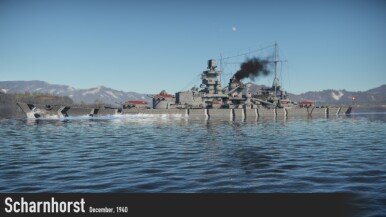The Scharnhorst (along with her sister ship Gneisenau) was designed as a battleship right from the start by the Kriegsmarine. However, restriction imposed by the Treaty of Versailles (and as Germany were unable to built any large calibre guns at that time due to the lack of industrial capabilities) forced the Kriegsmarine to fit her with smaller 283 mm guns. Launched in January 1939, Scharnhorst spent early WWII raiding British convoys in the Atlantic with her sister Gneisenau. In mid-1940, they also participated in the German invasion of Norway, during which they engaged the battlecruiser HMS Renown and sank HMS Glorious, which had been converted to an aircraft carrier, as well as their destroyer escorts. In 1943, while attempting to raid Allied convoys on their way to the Soviet Union, Scharnhorst and her five escorting destroyers were intercepted by a British task force, including the battleship HMS Duke of York, light cruisers HMS Belfast and HMS Norfolk, and destroyer HMCS Haida, in the Battle of the North Cape on 26 December. Scharnhorst was sunk, with only 36 survivors. With all other German battleships damaged or otherwise engaged, the battle itself was a major turning point in Allied naval control in the Atlantic and Arctic, and would prove to be the last battle between battleships in European waters.
It was introduced in Update "Winged Lions". Although the Scharnhorst is almost universally classed as a battleship in real life due to her protection, her fast top speed and smaller armaments compared to her contemporaries in the 1930s caused the British to classify the ship as a battlecruiser. This peculiar characteristic is reflected in-game, where the Scharnhorst's mobility, protection, and weaker but fast-firing guns made her a formidable heavyweight mid-to-close range brawler.















